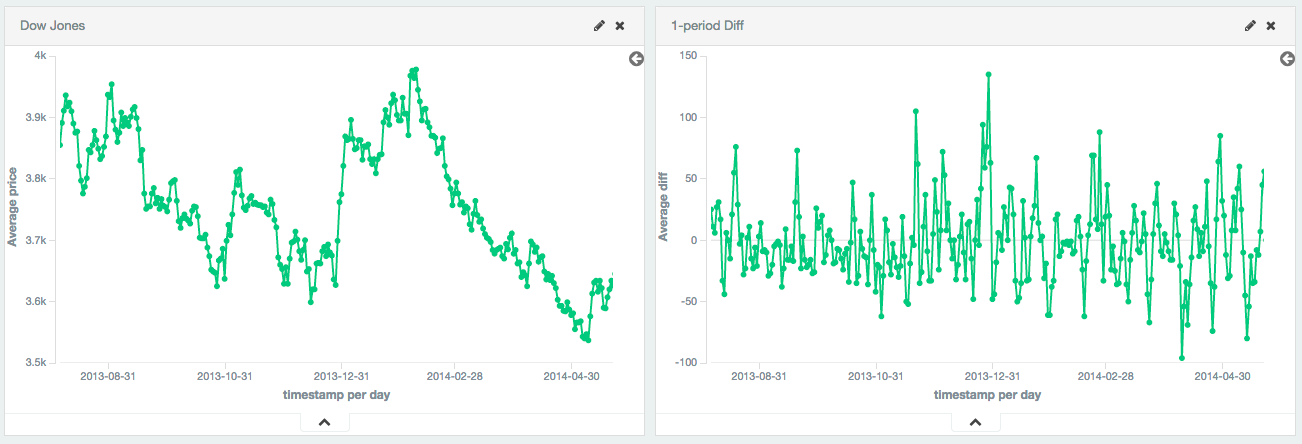Serial differencing aggregation
Serial differencing is a technique where values in a time series are subtracted from itself at different time lags or periods. For example, the datapoint f(x) = f(xt) - f(xt-n), where n is the period being used.
A period of 1 is equivalent to a derivative with no time normalization: it is simply the change from one point to the next. Single periods are useful for removing constant, linear trends.
Single periods are also useful for transforming data into a stationary series. In this example, the Dow Jones is plotted over ~250 days. The raw data is not stationary, which would make it difficult to use with some techniques.
By calculating the first-difference, we de-trend the data (e.g. remove a constant, linear trend). We can see that the data becomes a stationary series (e.g. the first difference is randomly distributed around zero, and doesn’t seem to exhibit any pattern/behavior). The transformation reveals that the dataset is following a random-walk; the value is the previous value +/- a random amount. This insight allows selection of further tools for analysis.

Larger periods can be used to remove seasonal / cyclic behavior. In this example, a population of lemmings was synthetically generated with a sine wave + constant linear trend + random noise. The sine wave has a period of 30 days.
The first-difference removes the constant trend, leaving just a sine wave. The 30th-difference is then applied to the first-difference to remove the cyclic behavior, leaving a stationary series which is amenable to other analysis.

A serial_diff aggregation looks like this in isolation:
{
"serial_diff": {
"buckets_path": "the_sum",
"lag": 7
}
}
| Parameter Name | Description | Required | Default Value |
|---|---|---|---|
buckets_path |
Path to the metric of interest (see buckets_path Syntax for more details |
Required | |
lag |
The historical bucket to subtract from the current value. E.g. a lag of 7 will subtract the current value from the value 7 buckets ago. Must be a positive, non-zero integer | Optional | 1 |
gap_policy |
Determines what should happen when a gap in the data is encountered. | Optional | insert_zeros |
format |
DecimalFormat pattern for theoutput value. If specified, the formatted value is returned in the aggregation’svalue_as_string property |
Optional | null |
serial_diff aggregations must be embedded inside of a histogram or date_histogram aggregation:
POST /_search
{
"size": 0,
"aggs": {
"my_date_histo": {
"date_histogram": {
"field": "timestamp",
"calendar_interval": "day"
},
"aggs": {
"the_sum": {
"sum": {
"field": "lemmings"
}
},
"thirtieth_difference": {
"serial_diff": {
"buckets_path": "the_sum",
"lag" : 30
}
}
}
}
}
}
- A
date_histogramnamed "my_date_histo" is constructed on the "timestamp" field, with one-day intervals - A
summetric is used to calculate the sum of a field. This could be any metric (sum, min, max, etc) - Finally, we specify a
serial_diffaggregation which uses "the_sum" metric as its input.
Serial differences are built by first specifying a histogram or date_histogram over a field. You can then optionally add normal metrics, such as a sum, inside of that histogram. Finally, the serial_diff is embedded inside the histogram. The buckets_path parameter is then used to "point" at one of the sibling metrics inside of the histogram (see buckets_path Syntax for a description of the syntax for buckets_path.